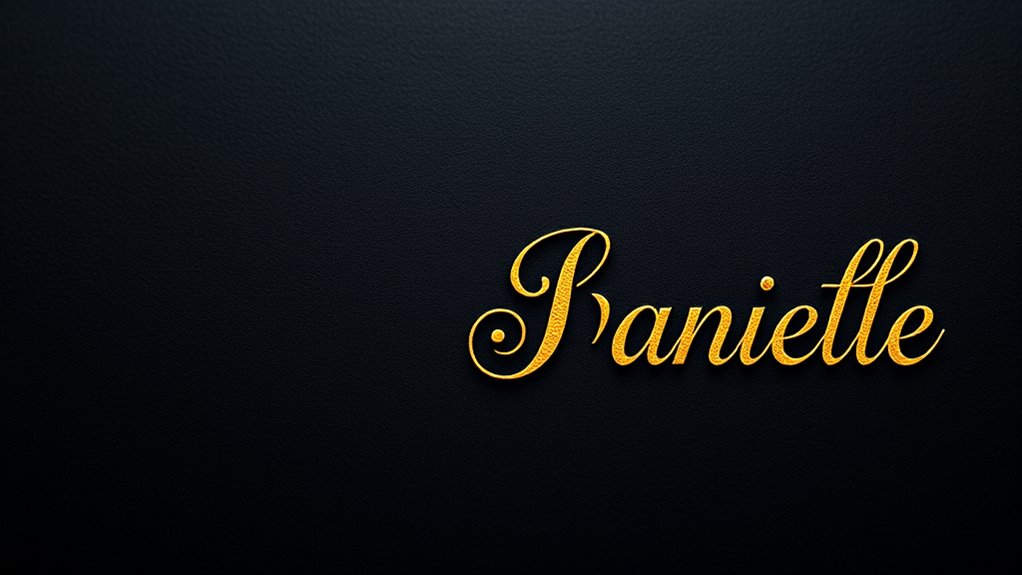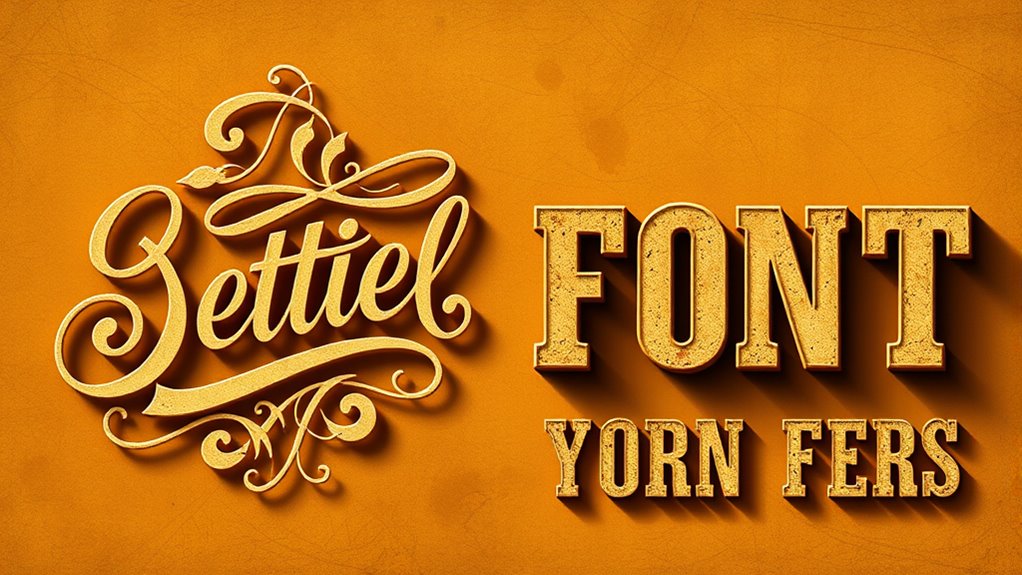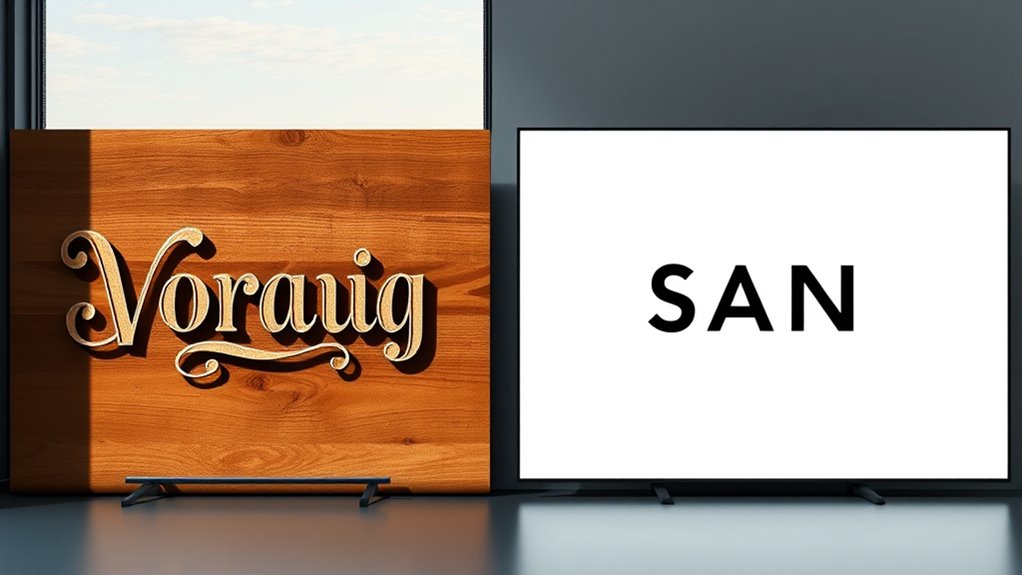To master timeless typography pairings, focus on combining classic fonts like serif and sans-serif or pairing elegant scripts with stable serif fonts. Balance modern with traditional styles for versatile looks, and use high-contrast or minimalist combinations to create impact and clarity. Vintage-inspired duos and thoughtful weight and style balancing add sophistication. Keep licensing in mind to guarantee professionalism. If you want to refine your skills further, exploring these pairings can open a timeless design edge.
Key Takeaways
- Pair serif and sans-serif fonts for a balanced, professional, and timeless look that enhances readability and contrast.
- Combine classic fonts like art deco and art nouveau for vintage-inspired, nostalgic appeal with modern versatility.
- Use serif with script or handwritten fonts to create elegant, refined designs suitable for luxury and invitations.
- Employ high-contrast typography with bold differences in weight and style for impactful, attention-grabbing visuals.
- Maintain harmony by balancing font weights, styles, and spacing to ensure cohesive and balanced typographic pairings.
Serif and Sans-Serif Combos That Never Fail

Pairing serif and sans-serif fonts can create a balanced and professional look that appeals to viewers. When combining these fonts, pay attention to letter spacing; adjusting it guarantees clarity and harmony between the styles. Serif fonts often lend a classic, authoritative feel, while sans-serif fonts provide a modern, clean touch. Be mindful of font licensing to avoid legal issues—choose licensed fonts or those with open licenses suitable for your project. This combo works well for headings and body text, offering contrast and readability. Keep in mind that the right pairing enhances visual flow and ensures your message is clear. Additionally, understanding how contrast ratio affects readability and visual impact can help you select the most effective font combinations. Managing the personality of fonts ensures your design communicates the intended mood and style effectively. Being aware of regional design preferences can also influence font choices and overall aesthetic harmony. By carefully selecting fonts and managing letter spacing, you’ll craft designs that are both appealing and compliant with licensing standards. Considering font pairing principles can further improve the overall harmony of your typography choices.
Classic Pairings for Elegant Editorial Layouts

Serif and script fonts create a refined, timeless look that elevates editorial layouts. When paired thoughtfully, these combinations highlight elegance without sacrificing readability. Explore how serif and script synergy can transform your designs into classic, sophisticated pieces. Incorporating vintage decor into your typography choices can further enhance the cultural richness and visual appeal of your editorial designs. Understanding the symbolism behind certain font styles can also deepen the thematic resonance of your layouts, making them more impactful.
Serif and Script Synergy
When designing elegant editorial layouts, combining serif and script typefaces creates a timeless and sophisticated look. Serif fonts provide a stable, classic foundation, while script fonts add a touch of calligraphy and handwriting elegance. This pairing works beautifully when you choose a decorative and ornamental script that emphasizes fluidity and movement, contrasting with the more structured serif. The key is balance: use the serif for body text or headlines and reserve the script for accents, initials, or highlights. This synergy evokes a sense of craftsmanship and refinement, perfect for luxury brands, invitations, or editorial spreads. By merging the traditional strength of serif with the delicate beauty of script, you craft layouts that feel both classic and personal, capturing attention with their refined harmony. Additionally, selecting fonts with complementary regional flavors and traditions ensures the design resonates deeply with the intended audience. Incorporating vetted font combinations can further enhance the cohesiveness and visual appeal of your editorial design. Considering market trends and audience preferences can help in choosing the most effective typeface pairings for your project.
Timeless Font Combinations
Timeless font combinations are essential for creating elegant editorial layouts that stand the test of time. They draw from typography history, blending classic styles that have proven their staying power. When choosing these pairings, consider font licensing to guarantee legal use across projects. A well-crafted combination pairs a serif with a sans-serif or a script with a clean sans-serif for contrast and harmony.
- Classic serif with a modern sans-serif for readability and sophistication
- Elegant script paired with a simple sans-serif to add flair
- Vintage-inspired typefaces that evoke timeless charm
- Monospaced fonts combined with traditional serifs for a balanced look
- Combining historical fonts with contemporary styles for a fresh yet classic feel
Modern Meets Traditional: Transitional Font Pairings

Transitional fonts blend modern and traditional styles, allowing you to create versatile and balanced designs. By contrasting stroke weights, you can add visual interest while maintaining harmony between formal and casual elements. These pairings help you craft layouts that feel both contemporary and timeless. Incorporating principles of ethical hacking can inspire innovative design solutions that anticipate user needs and security considerations. Understanding typography pairing techniques enables designers to develop cohesive visual narratives that resonate across various media. Additionally, embracing creative practice can foster experimentation with font combinations, leading to more dynamic and engaging designs. Considering space utilization in your typographic choices can further enhance readability and overall aesthetic appeal.
Blending Styles Seamlessly
Blending modern and traditional styles creates dynamic and versatile font pairings that can elevate your designs. Progression fonts serve as a perfect bridge, combining clean lines with classic touches. To achieve a seamless blend, consider pairing handwritten fonts with geometric fonts for contrast and harmony. Handwritten styles add personality, while geometric pairings provide structure. This approach keeps your design fresh without feeling disjointed.
Here are some tips to master this balance:
- Mix a script handwritten font with a sleek sans-serif
- Use serif fonts with modern, minimalistic typefaces
- Incorporate progression fonts with bold, geometric headlines
- Pair elegant script with straightforward body text
- Experiment with subtle contrasts to highlight key elements
Contrasting Stroke Weights
Contrasting stroke weights can dramatically enhance the visual impact of your font pairings, especially when combining modern and traditional styles. Using thick, bold strokes alongside delicate, calligraphic flourishes creates a dynamic balance that draws attention. This contrast emphasizes the elegance of calligraphic elements against the clean structure of geometric grids, adding sophistication and clarity. For transitional fonts, pairing a heavy-weight serif with a light, script-inspired typeface works well.
| Font Pairing | Description |
|---|---|
| Bold Serif + Thin Script | Highlights calligraphic flourishes with strong structure |
| Heavy Sans + Light Serif | Creates modern-meets-traditional contrast |
| Geometric Grid + Script | Balances precision with fluidity |
| Thick Stroke + Fine Line | Adds depth and visual interest |
| Block Lettering + Decorative Script | Enhances hierarchy and ornamentation |
Harmonizing Formal and Casual
Achieving harmony between formal and casual styles is essential for creating versatile font pairings that feel both polished and approachable. Smooth font pairings blend calligraphic elegance with playful type mixing, striking a perfect balance. To master this, consider pairing a refined serif with a relaxed script or a traditional sans-serif with a quirky display font. This approach guarantees your design feels sophisticated yet inviting. Recognizing the importance of visual harmony can help ensure your font combinations are cohesive and effective.
High-Contrast Pairings for Impactful Designs

High-contrast typography pairings can create bold, attention-grabbing designs that communicate your message with clarity and impact. You can leverage color psychology to evoke specific emotions—think pairing a vibrant red with a sleek black for urgency or excitement. Select font combinations with stark differences in weight, size, or style to enhance contrast and draw focus. Keep in mind, choosing fonts with proper licensing guarantees your design remains professional and legal. High-contrast pairings work best when you balance readability with visual tension, making key elements stand out without overwhelming the viewer. Additionally, understanding typography pairings and how they interact can help you craft more dynamic and effective designs. Recognizing the importance of color contrast can significantly improve the clarity and visual impact of your work. Exploring somatic therapy techniques can also provide insights into how different elements work together to create harmony and effectiveness in your designs. By thoughtfully combining contrasting fonts and colors, you craft designs that are memorable and effective, capturing attention instantly and delivering your message with power.
Minimalist Font Combinations for Clean Aesthetics

Minimalist font combinations emphasize simplicity and elegance, creating clean and uncluttered aesthetics in your designs. To achieve this, focus on pairing fonts with balanced letter spacing that enhances readability without overwhelming the eye. Use subtle color harmony between typefaces and backgrounds to maintain a cohesive look. Choose sans-serif fonts for a modern feel or pair a delicate serif with a bold sans-serif for contrast. Keep font sizes consistent to avoid visual clutter. Limit your color palette to neutral or pastel tones for a sleek finish, allowing your typography to shine. Remember, less is more—let your font choices speak for themselves.
- Prioritize legibility with appropriate letter spacing
- Use harmonious color schemes for cohesion
- Mix simple sans-serifs with elegant serifs
- Maintain consistent font sizes and weights
- Keep color contrast subtle for a refined look
Vintage-Inspired Typography Duos

Vintage-inspired typography duos blend classic charm with modern versatility, allowing you to evoke nostalgia while maintaining readability. Combining styles like art deco and art nouveau creates striking contrasts—bold geometric lines paired with elegant, flowing curves. These duos work well for projects aiming to capture a sense of history with contemporary appeal. For example, pairing an art deco sans-serif with an art nouveau serif enhances visual interest and clarity. Keep in mind the balance between ornate details and simplicity to avoid overwhelming your design. Here’s a quick overview:
| Style Pairing | Characteristics | Best Use Cases |
|---|---|---|
| Art Deco + Modern Sans | Geometric, sleek, with decorative accents | Branding, posters |
| Art Nouveau + Serif | Ornate, flowing, with subtle embellishments | Invitations, packaging |
| Vintage Script + Block | Elegant, nostalgic, with strong contrast | Logos, headlines |
Bold and Subtle: Balancing Weight and Style

While pairing vintage-inspired fonts often emphasizes harmony through stylistic contrasts, achieving a balanced look requires more than just mixing ornate and clean styles. Focus on the font anatomy to guarantee weight and style complement each other. Use color pairing strategically—lighter shades for subtle fonts and bolder hues for prominent text—to create visual hierarchy. When combining bold and subtle fonts, consider the thickness of strokes and the overall style to avoid clashing. Balance is key: a heavy font can anchor your design, while a delicate font provides contrast without overwhelming. Remember, consistency in style and thoughtful use of space help unify the pairing.
- Match stroke contrast with font weight
- Use color to highlight or de-emphasize
- Consider line spacing for readability
- Focus on font anatomy for harmony
- Keep style contrast intentional
Frequently Asked Questions
How Do I Choose Fonts That Complement Each Other Stylistically?
When choosing fonts that complement each other, focus on creating contrast and harmony to enhance visual hierarchy. Select one font with strong personality and another more neutral to balance the design. Use contrast in size, weight, or style to guide the viewer’s eye, but keep harmony by sticking to similar letterforms or styles. This approach helps your design look cohesive while clearly communicating your message.
What Are Common Mistakes to Avoid When Pairing Fonts?
Ever seen a font clash that ruins a design? Avoid overused pairings that make your work look generic. The biggest mistake? mixing fonts with drastically different moods or styles without considering hierarchy. Don’t rely solely on popular combinations; they can quickly become cliché. Instead, pay attention to contrast and harmony. Keep your choices intentional, and steer clear of pairing two similar fonts that lack distinction—they’ll just blend into the background.
How Does Font Pairing Influence the Overall Mood of a Design?
Font pairing profoundly influences the overall mood of your design by shaping its emotional impact and reinforcing your brand identity. When you choose complementary fonts, you create harmony that resonates with your audience, evoking the desired feelings—be it professionalism, playfulness, or elegance. Poor pairing can confuse or disconnect viewers, undermining your message. Thoughtful font choices help communicate your brand’s personality clearly, making your design more compelling and memorable.
Can Pairing Different Font Styles Improve Readability?
It’s interesting how pairing different font styles can improve readability, especially through strategic font hierarchy and visual contrast. When you choose contrasting fonts, your audience can easily distinguish headings from body text, guiding their eye naturally. This balance reduces confusion and makes your message clearer. So, yes, thoughtful font pairing isn’t just about style—it’s a practical tool to enhance clarity and guarantee your content is easily understood.
Are There Specific Font Combinations Best Suited for Digital Versus Print?
You should consider that some font pairings work better for digital, while others suit print, based on historical font trends. Use font pairing tools to explore combinations that enhance readability on screens versus paper. Digital fonts often favor clean, sans-serif styles, while print can handle more elaborate serif fonts. By understanding these distinctions, you guarantee your designs are effective and visually appealing across different mediums.
Conclusion
By exploring these timeless typography pairings, you’ll notice how the right combinations often feel like they’re meant to be, almost like a coincidence. When you mix classic with modern, bold with subtle, or vintage with fresh, everything just falls into place effortlessly. Keep experimenting, and you might find that the most unexpected pairings create the perfect harmony in your designs—proving that great typography often happens when you least expect it.









